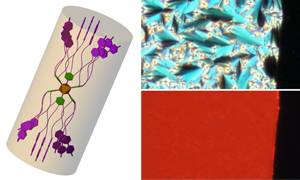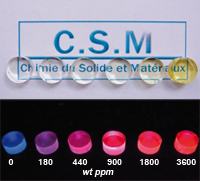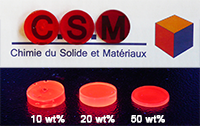

But what is a cluster ?
The term "metal atom cluster" was introduced by F.A. Cotton in 1964 to describe "a finite group of metal atoms
held together by metal-metal bonds. "
All metallic electrons are localized on metal-metal bonding orbitals. Depending on their number, metallic clusters can show either:
- -one or two electron reversible redox process,
- magnetism or
- luminescence.
In particular, they can be highly emissive in the red-NIR region displaying tens of microseconds excited state lifetimes. Such properties offer promising perspectives for applications in cluster-based materials like in the fields of biology, optical telecommunication network, infrared signaling devices, displays or laser systems.
By following the links below, you will get an idea about the type of our new achievements
Liquid crystals Hybrid polymers Molecular Materials Nanomaterials
Clustomesogens

P.O.M. pictures under normal and UV light
Clustomesogens are liquid crystal containing transition metal clusters. They combine the self assembling abilities of liquid crystal compounds to the luminescence properties of metallic clusters. Several ways can be followed to obtain such soft molecular material: i) a covalent grafting of liquid cristalline organic ligands on the metallic scaffold, ii) a ionic assembling techniques consisting in surrounding the anionic metallic scaffold by cationic liquid crystalline organic molecules and iii) a double supramolecular approach combining host-guest complex formation and electrostatic interactions consisting in complexing the metallic cation of the ternary solid state AnM6X14 with a liquid crystalline Crown ether derivative . This part of our research activities is actually financed by ANR and DFG through the SNAPSTER project
Selected publications:
Lord of The Crowns: A New Precious in the Kingdom of Clustomesogens,
K. Guy, P. Ehni, S. Paofai, R. Forschner, C. Roiland, M. Amela-Cortes, S. Cordier, S. Laschat, Y. Molard
Angew. Chem. Int. Ed., 2018, 57, 11692-11696
Clustomesogens: Liquid Crystalline Hybrid Nanomaterials Containing Functional Metal Nanoclusters,
Y. Molard
Acc. Chem. Res., 2016, 49, 8, 1514 - 1523
Clustomesogens: liquid crystal based transition metal clusters,
Y. Molard, F. Dorson, V. Circu, F. Artzner, S. Cordier
Angew. Chem. Int. Ed., 2010, 49, 3351-3355
Ionically Self Assembled Clustomesogen with Switchable Magnetic / Luminescence Properties containing [Re6Se8(CN)6]n- (n = 3, 4) anionic clusters,
Y. Molard, A. Ledneva, M. Amela-Cortes, V. Circu, N. G. Naumov, C. Meriadec, F. Artzner, S. Cordier
Chem. Mater., 2011, 23, 5122-5130
Susanta K. Nayak, Maria Amela-Cortes, Claire Roiland, Stephane Cordier, Yann Molard
Chem. Commun., 2015, DOI: 10.1039/C4CC10085A
"Luminescent hybrid liquid crystal", Y. Molard, S. Cordier, M. A. Amela-Cortes, F. Dorson, US Pat. Appl. Publ., 2011, US20110130565
They speak about it:
RSC Chemistry World ,
Ouest France ,
Materials Today ,
Intute,
Nanowerk
, Angewandte Chemie's Editors ,
Innovations-report.com,
Science spot,
PhysOrg.com,
European Science News ,
AZoNano ,
University of Rennes 1.
Luminescent Hybrid polymers

under normal and UV light

sensitization in Pellets of Cluster@PMMA

under normal and UV light
A major challenge in the preparation of luminescent polymers containing transition metal clusters is the prevention of phase separation and aggregation of the inorganic species in the host matrix. Since 2010, we developed several strategies to tackle this problem. Our attention has been focused first on the clusters modification by covalent grafting of organic ligands bearing polymerisable moieties. Obtained bulk samples retained the luminescence properties of the metal cluster while keeping the processability of the host matrix. These hybrid materials have a great potential in telecommunication dedicated applications such as rare earth doped Amplifiers for the datacom Bands as they efficiently sensitize the infra red rare earth metal luminescence. Then, we modified the cluster compound with polymerizable organic counter cations and could dope PMMA up to 50 wt%. depending on the polymerizable function, cluster compounds can be integrated in all kinds of polymers. The third strategy relies on supramolecular interactions. Polymers modified with polyethyleneoxide chains interact efficiently with the alkali cations contained in the cluster compounds leading to homogeneous hybrids. Mastering the integration of emissive clusters in polymers, our researches in this area are now directed toward the exploitation of luminophores complementarities to develop multifunctional materials with potential applications in optoelectronic, optic, solar concentrators, display or lighting.
Selected publications:
Self-erasable Inkless Imprinting Using a Dual Emitting Hybrid Organic-Inorganic Material
S. Khlifi, N. Fournier Le Ray, S. Paofai, M. d. L. A. Amela Cortes, H. Akdas-Kilic, G. Taupier, S. Derien, S. Cordier, M. Achard, Y. Molard,
Materials Today, 2020, in press. DOI: 10.1016/j.mattod.2019.12.002
When a Red–NIR-Emissive Cs2[Mo6Br14] Interacts with an Active Diureasil–PEO Matrix: Design of Tunable and White-Light-Emitting Hybrid Material
E. Ferreira Molina, N. A. Martins de Jesus, S. Paofai, P. Hammer, M. Amela-Cortes, M. Robin, S. Cordier, Y. Molard,
Chem. Eur. J., 2019, 25 (67), 15248-15251
Tuned Red NIR phosphorescence of polyurethane hybrid composites embedding metallic nanoclusters for oxygen sensing. ,
M. Amela-Cortes, S. Paofai, S. Cordier, H. Folliot, Y. Molard,
Chem. Commun., 2015, DOI: 10.1039/C5CC01867F
Deep red luminescent hybrid copolymer materials with high transition metal cluster content ,
M. Amela-Cortes, A. Garreau,S. Cordier, E. Faulques,J.-L. Duvail, Y. Molard
J. Mat. Chem. C, 2014, 2, 1545-1552
Sensitization of Er 3+ Infrared Photoluminescence Embedded in a Hybrid Organic-Inorganic Copolymer containing Octahedral Molybdenum Clusters,
Y. Molard, C. Labbe, J. Cardin, S. Cordier
Adv. Func. Mater., 2013, 23, 38, 4821-4825
Red-NIR Luminescent Hybrid PMMA Containing Covalently Linked Octahedral Rhenium Metallic Clusters,
Y. Molard, F. Dorson, K. A. Brylev, M. A. Shestopalov, Y. Le Gal, S. Cordier, Y. V. Mironov, N. Kitamura, C. Perrin
Chem. Eur. J., 2010, 16, 5613-5619
They speak about it:
CNRS Institute of Chemistry (PU) , CNRS Institute of Chemistry , Industrie et technologie , CEA Iramis , Les defis du CEA, November 2013, p 9
Molecular Materials
in construction
Selected publications:
Selective functionalisation of Re6 Cluster Anionic Units: From Hexa-Hydoxo [Re6Q8(OH)6]4- (Q = S, Se) to neutral trans-[Re6Q8L4L'2] Hybrid Building Blocks
F. Dorson, Y. Molard, S. Cordier, B. Fabre, O. Efremova, D. Rondeau, Y. Mironov, V. Circu, N. Naumov, C. Perrin
Dalton trans., 2009, 1297-1299
Electronic Effects and Absorbtion Properties of Supramolecular Assemblies Based on TTF-CH=CH-Py Ligands Coordinated to [Mo6Xi8]4+ Cluster Cores (X=Cl, Br, I)
G. Prabusankar, Y. Molard, S. Cordier, S. Gohlen, Y. Le Gal, C. Perrin, S. Kalahal, J. F. Halet, L. Houahab
Eur. J. Inorg. Chem., 2009, 2153-2161
Nanomaterials
Liquid crystalline ZnO hybrid nanoparticles
Organizing functional nanoparticles at the nanometric scale by using supramolecular chemistry concepts has been recently defined as Nanoarchitectonic. In this frame, we functionalized ZnO spherical nanocrystals of 5 nm with organic promesogenic units. The resulting functional nanohybrids self assemble into layered structures. One of them shows a nematic behavior that allows its integration into a LC device by mixing with commercial nematic LC mixture.
Selected publications:
Voltage-Driven Photoluminescence Modulation of Liquid-Crystalline Hybridized ZnO Nanoparticles
C. Neaime, M. Prevot, M. Amela-Cortes, V. Circu, F. Grasset, H. Folliot, Y. Molard
Chem. Eur. J., 2014, 20(42), 13770-13776
One pot synthesis and characterization of bi-functional phosphor-magnetic @SiO2 nanoparticles:controlled and structured association of Mo6 cluster units and -Fe2O3 nanocrystals
F. Grasset, F. Dorson, Y. Molard, S. Cordier, V. Demange, C. Perrin, V. Marchi-Artzner, H. Haneda
Chem. Commun., 2008, 4729-4731
When "metal atom clusters" meet ZnO Nanocrystals: Novel ((n-C4H9)4N)2Mo6Br14@ZnO hybrid
F. Grasset, Y. Molard, S. Cordier, F. Dorson, M. Mortier, C. Perrin, M. Guilloux-Viry, T. Sasaki, H. Haneda
Adv. Mater., 2008, 20, 9, 1710-1715